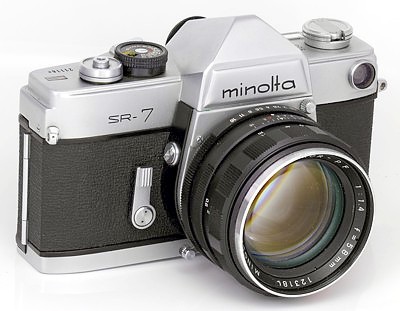
In 1946, the company produced Japan's first postwar camera, the Semi III. Tashima, who was determined to put Minolta back on its feet, had employees dig through the company's bombed-out factories to salvage parts. One of the primary goals of the Allied occupation forces was the restoration of Japan's economy.

Japan ultimately was devastated by the war. Demand was so high that it opened the Itami plant in 1942 solely to manufacture optical glass. Chiyoda Kogaku Seiko produced high-powered binoculars and other optical instruments for wartime use. military used electronics to track enemy ships and aircraft, the Japanese depended upon optics. As it became clear that war was ahead, Japanese military planners determined to develop precision optical equipment for range finding, navigation, and bombing aids.ĭuring World War II, when the U.S. In September 1940, Japan joined Germany and Italy in the Tripartite Pact, which divided Asia and Africa into spheres of influence. Production of Binoculars and Other Optical Products During World War II That same year, Tashima reorganized and incorporated the company and renamed it Chiyoda Kogaku Seiko Kabushiki Kaisha (Chiyoda Optics and Fine Engineering Limited) to reflect its broader focus. His emphasis on innovation led to the development of the first twin-lens reflex camera in Japan, the Minolta Flex, in 1937. Tashima built new production facilities, including a factory devoted to lens production at Sakai. The Vest's success made expansion possible. For the first time, a Minolta product was successful outside of Japan. The innovation made the Vest easier to focus and less expensive. When a shortage of imported sheepskin threatened production, the company developed the first rigid bellows of synthetic resin for the Minolta Vest. Like other camera companies, Minolta used sheepskin to make a flexible camera bellows.

In 1934, Nichi-Doku Shashinki Shoten began to sell the Minolta Vest, the product that made a reputation for the company. The name reminded Tashima of a proverb his mother frequently used, meaning that the more successful one becomes, the more humble one must be: "The ripest ears of rice bow their heads lowest." The name, however, also has a Western meaning, as an acronym for Machinery and Instruments Optica l by Tashima. Tashima later referred to his company as "a small boat which set sail right into the storm." Nevertheless, Tashima promoted development of new camera models as the Depression intensified and introduced several models in 19.Ī new model introduced in 1933 first carried the Minolta brand name, a name Tashima created to sound like the Japanese word "minoru-ta," which means ripening rice field. Within three months, production had grown to 100 cameras a month.Ī year later, the Great Depression hit Japan hard, bringing labor strife and strikes. By March 1929, the staff of about 30 was producing one bellows camera, called the Nifcalette, each day-with imported lens and shutter. Partners Willy Heilemann, an importer of German items in Kobe, and Billy Neumann, a German engineer with a background in optical instruments, brought state-of-the-art German technology to the new firm. The name reflected the company's reliance on German technology and expertise. Tashima opened shop on November 11, 1928, calling his venture Nichi-Doku Shashinki Shoten (Japan-Germany Camera Company). Unable to start his new venture as a part of Tashima Shoten, Tashima borrowed money from his father's chief clerk and went into business on his own. Japanese businessmen, including Tashima's father, opposed the idea of producing optical equipment domestically. In Paris, Tashima toured a factory that specialized in high-grade optics, and decided he could produce similar equipment profitably in Japan.

began modestly in 1928 when 28-year-old Kazuo Tashima agreed to represent his father's import-export company, Tashima Shoten, on a government-backed trade mission to Paris to promote Japanese silk. The company has production facilities in Japan, the United States, Germany, France, Malaysia, China, Hong Kong, and Brazil, and a worldwide marketing network.ġ928: Japan-Germany Camera Company Begins to Build Cameras is one of Japan's "big five" camera makers and a leading manufacturer of digital office equipment, including photocopiers, printers, word processors and other imaging products, radiometric instruments, and planetariums.


 0 kommentar(er)
0 kommentar(er)
